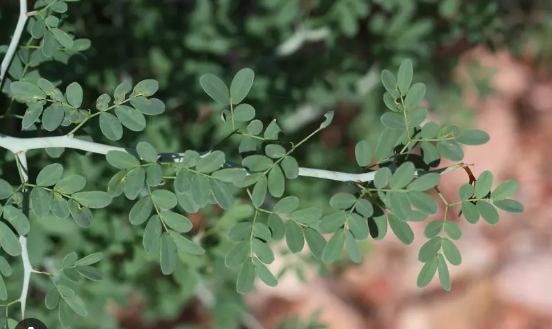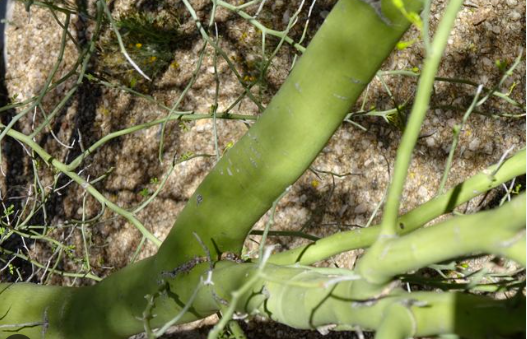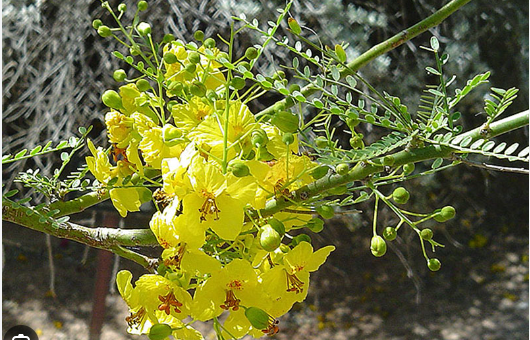
The Blue Palo Verde tree (Parkinsonia florida) is a species of palo verde native to the Sonoran Deserts in the Southwestern United States and Northwestern Mexico, including the Baja California peninsula. It is a characteristic woody plant along washes in the Colorado desert, and occasionally in the Mojave’s mountains. Its name, derived from Spanish, translates to “green pole or stick,” a fitting description for its characteristic green trunk and branches.
The plant’s trunk, branches, and leaves can be blue-green or gray-green in color, hence the common name. The plant is drought-deciduous, shedding its foliage for most of the year, leafing out after rainfall. Photosynthesis is performed by the gray-green branches and twigs, regardless of absent leaves. If transplanted in the right location, this tree grows up to 36 inches per year, reaching up to 35 feet tall.
This is a common tree for landscaping in arid regions. In spring, the Blue Palo Verde produces masses of bright yellow flowers, which are a rich source of nectar and attract a variety of pollinators, including bees, butterflies, and hummingbirds. The flowers are followed by small, flat, brown seed pods that contain the tree’s seeds.
The Blue Palo Verde is a fast-growing tree, capable of reaching its full height in just a few years. It prefers full sun and well-drained soil, and is highly drought-tolerant once established. The tree’s roots are deep and extensive, allowing it to tap into underground water sources and withstand periods of extended drought. The tree is hardy in Sunset’s Climate Zones 8 to 14 and 18 to 20.
The Blue Palo Verde is thought to have arrived in the Tucson Basin relatively recently, approximately 4,240 years ago according to pack-rat midden evidence. The official scientific classification of the Blue Palo Verde came in 1830. Irish botanist Thomas Coulter, while exploring near Hermosillo, Mexico, encountered the tree and categorized it as Parkinsonia florida. It was designated the official state tree of Arizona in 1954, joining the ranks of the cactus wren, bola tie, and saguaro cactus blossom as a state symbol. In 1966, it was also named the “city tree” of South Miami, Florida.
Historically, the Blue Palo Verde has been an important traditional source of tannin for leatherwork among the indigenous peoples of the Sonoran Desert. The Pima and Tohono Oʼodham tribes of Arizona used the tree’s seeds as a food source, grinding them into flour to make cakes and mush. The wood was also used for carving ladles and other utensils.
Today, the Blue Palo Verde is cultivated as an ornamental plant and tree by specialty plant nurseries, for planting as a shrub or multi-trunked small tree in drought tolerant and wildlife gardens of suitable climates. It offers an unusual green-blue silhouette in gardens, and delicately patterned light shade over patios.
Blue Palo Verde Tree – Identification Guide
Leaves

Bark

Flower

How to Propagate Blue Palo Verde Trees
- Gather palo verde seeds in late summer or early autumn after pods dry out and turn light brown. Shake the seed pod and listen for a rattling sound, which indicates that the seeds have fully dried out. Collect one or two seed pods.
- Snip off the ends of the seed pods with pruning shears and pry them open to extract the seeds. Pick out the flat, light brown seeds. Inspect each seed for signs of pest damage or mold. Discard any that have obvious signs of damage.
- Nick the end of each palo verde seed with a utility knife. Press the blade against the seed coat until it is deeply incised but not completely punctured. Soak the nicked seeds in warm water overnight to further weaken the hard, impermeable seed coat.
- Prepare a planting container for each palo verde seed. Use 7-inch plastic pots with at least two drainage holes at the base. Fill the pots with a mixture of 2 parts coarse sand, 1 part compost and 1 part perlite. Add water to the mixture until it feels moderately moist in the top 2 inches.
- Sow one palo verde seed in each pot. Make a planting hole that is 1/4 to 1 inch deep. Place the seed inside the hole and cover it with a loose layer of the growing mixture. Spread a 1/4-inch-thick layer of mulch over the surface to help hold moisture in the soil.
- Place the pots inside a lightly shaded cold frame. Warm the pots to around 70 degrees Fahrenheit using a germination mat. Check the moisture level in the growing mixture each morning. Add water whenever it feels barely damp in the top 1/2 inch.
- Watch for the first seedlings in approximately one to two weeks. Remove the germination mat once the seeds sprout. Continue to water whenever the growing mixture dries out in the top 1/2 inch.
- Grow the palo verde seedlings in a very lightly shaded area of the garden during their first summer. Provide 1 inch of water each week during the summer months. Acclimate the palo verde seedlings to direct sun in late summer so they won’t wilt after transplant.
- Transplant the palo verde saplings into a permanent bed in early autumn after the first rainfall. Choose a sunny planting site with sandy, fast-draining soil. Space multiple trees at least 20 feet apart.
Common Problems that Associated With Blue Palo Verde
Overwatering: While Blue Palo Verde needs some water, especially when young, overwatering is a major threat. Their desert adaptation means they’re susceptible to root rot in constantly moist soil.
Weeds and Vertebrates: Weeds and vertebrates like rabbits and squirrels can pose threats to the tree, either by competing for resources or causing physical damage.
Palo Verde Borer: The Palo Verde root borer, also known as the palo verde beetle (Derobrachus hovorei), these beetles target the roots of the tree, especially stressed trees. Signs include wilting, branch dieback, and sawdust around the base.
Witches’ Broom: This isn’t a witch’s curse, but a virus that causes dense, tangled growth on branches. While not fatal, it can affect the tree’s appearance and health.
Spider Mites: These tiny pests can infest Blue Palo Verde, sucking sap and causing yellowing or browning leaves.
Mistletoe: While uncommon, desert mistletoe can parasitically attach itself to the Blue Palo Verde, stealing nutrients and weakening the tree.